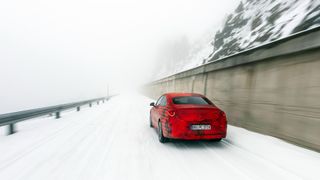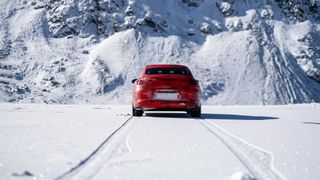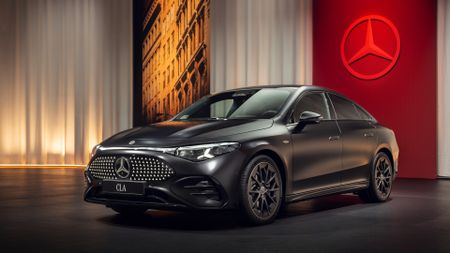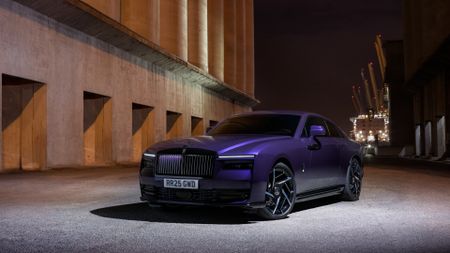

I’m braced in the passenger seat of the electric CLA coupe, Mercedes-Benz’s biggest launch of 2025, as engineer Timo Stegmaier floors the accelerator. On packed snow punctuated with dark strips of potential black ice. The thermometer is down at -16˚C as the electronic speedo’s digits hurtle upwards from 37 to beyond 100kmh, or 62 miles per hour.
I’d be reaching for the snow chains on this closed Alpine track ascending to the Timmelsjoch’s 2474m peak. But aside from 18-inch Michelin winter tyres, the CLA is dependent on Mercedes’ new generation 4Matic four-wheel drive to put the power down – and prevent us from hurtling into the icy valley below. Welcome to the first dynamic test of the new entry-level Mercedes-Benz.
It’s fair to say Mercedes’ first-generation electric cars have not lived up to the brand’s billing as ‘the best or nothing’. Take the EQS limousine: a huge battery enables decent range but its ride quality and rear comfort aren’t in the S-class’s league and its 400-volt electrical architecture is eclipsed by Hyundais and Kias.
“This is a new generation and it’s the benchmark,” counters Stegmaier, head of Mercedes electric drive systems. Underpinning the CLA – and plenty more Mercs besides including successors to today’s EQA and EQB electric SUVs – is a box-fresh chassis codenamed MMA (Mercedes Modular Architecture).

Mercedes hasn’t cut any corners on the specification. First up it packs an 800-volt electrical architecture (twice the energy of today’s Tesla Model 3 and the aforementioned EQS) which boosts charging capability: peak recharging is a potent 320kW on a DC ultrarapid charger.
And Benz claims to have finessed the 85kWh or 58kWh batteries, electric motors, regenerative braking, heat pump and power electronics including the inverter to boost range. “Efficiency is the new currency, and the components lie at the heart of that efficiency” is Stegmaier’s sales pitch.
He has a point, proven by a world record when Mercedes covered 3717km (2309 miles) in 24 hours of test track driving. Stegmaier’s team wasn’t hanging about – they averaged 96mph in warm spring Italian weather – but thanks to the single-motor CLA’s efficiency and rapid recharging, refuelling downtime was limited to 40 stops of around 10 minutes each (under 7 hours). The upshot was Mercedes took the Nardo circuit’s EV efficiency record from Porsche’s Taycan.
Sign up to the T3 newsletter for smarter living straight to your inbox
Get all the latest news, reviews, deals and buying guides on gorgeous tech, home and active products from the T3 experts

It all adds up to some impressive economy and range projections – Stegmaier reckons the CLA can average 5.18 miles per kWh, leading to a potential range in excess of 466 miles. A single-motor/long range Polestar 2 averages 4.2 miles per kWh and claims a range of 408 miles – on the test cycle, not in the real world.
Like the Polestar the new, entry-level CLA is rear-wheel drive, whereas power is sent to the front wheels on today’s combustion-powered Merc coupe and its EQA 250 electric cousin. Why the switch? “Because it’s more dynamic,” shoots back Stegmaier. The steering won’t be corrupted by torque being sent to the front axle and it also means the MMA platform is suitable to underpin the next C-class saloon, for example.
The CLA has a 200kW (268bhp) permanently excited synchronous motor, or Electric Drive Unit (EDU) in Mercedes-speak, spinning the rear axle. Power is transmitted via Mercedes first two-speed EV gearbox to provide the best blend of response and efficiency: the first gear is short for snappy acceleration, then a second gear with a longer ratio kicks in to provide good motorway efficiency and prolonged power delivery at higher speeds. Top speed is 130mph, high for an electric car.

Another efficiency breakthrough comes from the use of silicon carbide in the inverter, a crucial component which converts the battery’s Direct Current to Alternating Current for the motor, adjusts the motor’s rotational speed and helps capture kinetic energy to recharge the battery. Silicon carbide suffers less resistance and switching losses than a typical silicon inverter, and can be squeezed into a smaller design because it retains less heat. That’s all good for efficiency – Mercedes claims the rear motor is up to 93 per cent efficient at a cruise.
Because this is a 4Matic car, there’s also a motor on the front axle packing 80kW (107bhp) of boost. This EDU has a simpler design with a single gear set aligned to a Disconnect Unit, which can switch drive in and out within two milliseconds. That’s ideal when Stegmaier is booting the accelerator on a slippery slope, activating the forward motor to help the front wheels take some of the strain to claw the coupe forward. Typically the front motor is dormant to prevent a drag on efficiency: “it comes on when you want full acceleration or for stability,” says Stegmaier.
The CLA runs Mercedes new operating system, MB.OS, and its computing power, myriad sensors and response times enable the electronics to instantly juggle front motor power under high load or if it detects a loss of traction. “The silicon carbide inverter makes that control faster and it’s much more efficient,” says the electric drive system expert.

Stegmaier’s ice rink acceleration run is eased by the rolling start and is notably undramatic – there’s no twitchy rear end or stability control obviously managing torque to the wheels to control slip. He describes the momentum as “incredible”, whereas to me it feels about as brisk and punchy as a Golf GTi hot hatch’s. But I have no issue when Stagemaier says “the traction is so, so good: we are on the border of where the car will start slipping but [we don’t go over the edge] because of the software and the intelligence of the drivetrain.”
Having turned around in the glistening sunshine at the Timmelsjoch’s summit, it’s time for some brake tests on the descent. Stegmaier has the CLA in D-minus mode to trigger maximum electronic regeneration, with both motors capable of acting in reverse to feed captured energy back to the battery. He lifts off the brake and the coupe rapidly comes to a halt, without any retardation from the friction brakes. “It can recuperate up to 200kW on both the front and rear because I want to give back the most energy possible to the customer.”
D-minus is the perfect mode to gradually slow the car for twisty country roads or the Timmelsjoch’s icy hairpins. But there’s also ‘D’ with less retardation and regen, and D-plus to keep the CLA sailing along on the motorway to avoid wasting energy. Brake modes are toggled via a lever behind the steering wheel, or set the Benz in D-auto to let it decide recuperation levels.

All this motor action generates heat, which the CLA can recover using its standard heat pump. This can also scavenge heat from the battery and compress external air to warm the cockpit and batteries. The heat pump’s air-to-air system is yet another upgrade on today’s Mercedes tech: the previous system channelled heat indirectly via a water circuit.
Next up is an emergency brake into a downhill corner from 50km/h (31mph). The anti-lock brakes chirrup gently and I hear the Pilot Alpin rubber scraping the snow, but there’s no danger of the stable CLA breaking traction. While the speed isn’t taxing, plenty of UK drivers will have slid on snow at lower speeds in cars without winter rubber.
The new CLA – which will shed its red disguise to go public in the spring and arrive in UK dealerships in autumn 2025 – will come with a choice of two batteries, as does Volvo’s EX30. This 4Matic prototype harnesses Mercedes’ premium NMC (Nickel Manganese Cobalt) battery, which has been upgraded over its predecessor’s graphite anode with the addition of silicon oxide, boosting energy density by 20 per cent. The total usable capacity is 85kWh.

The alternative cell chemistry is LFP (lithium iron phosphate), which is less energy-dense and less effective at maintaining its charge in cold temperatures (hence the standard heat pump). But it uses zero cobalt and is cheaper to manufacture, so this will be the entry-level electric CLA costing an estimated £49,000 when sales begin.
The LFP battery’s capacity is 58kWh, despite it being packed just like the far punchier NMC battery: 48 cells wired in series in four rectangular modules within the hard casing. Both are liquid-cooled, allowing cells to be warmed or chilled on the go to optimum temperature to enable that 320kW charging peak.
Stigmaier signs off with a stat to neatly skewer range anxiety: the CLA can travel 789 miles with just two 10-minute charging stops. Almost 800 miles! It’s the final example of an electric car that feels lovingly engineered – and a gamechanger for Mercedes-Benz EV tech.
Phil has been writing about cars for more than 25 years, primarily for Car magazine where he led the editorial department for 18 years and positioned the title at the forefront of the electric, connected and autonomous revolution. He’s also written for Auto Express, Autocar, Car Design News and numerous other titles. Phil loves road trips, convincing Peugeot to ship a 408 to America so he could drive it to locations from the Netflix show Stranger Things, and journeying to Romania’s legendary and very twisty Transfagarasan Highway – in the tiny Dacia Spring electric car.
-
 T3 Luxury Month 2025: the greatest luxurious gadgets you need for your home
T3 Luxury Month 2025: the greatest luxurious gadgets you need for your homeFrom watches to cars, T3 is rounding up the best of the best for Luxury Month
By Bethan Girdler-Maslen Published
-
 This Switch 2 news will change how I use my console completely, and I can't wait
This Switch 2 news will change how I use my console completely, and I can't waitSharing digital games is changing
By Max Freeman-Mills Published
-
 This new EV charger can charge as quickly as filling with petrol at the pump
This new EV charger can charge as quickly as filling with petrol at the pumpBYD's super e-Platform EV charger promises 1,000 kW charging at 1,000 volts
By Alistair Charlton Published
-
 Xiaomi just revealed one of the most interesting EVs of the year
Xiaomi just revealed one of the most interesting EVs of the yearThe Xiaomi SU7 Ultra is a Chinese EV ready to take on Porsche and Tesla
By Alistair Charlton Published
-
 The all-new Mercedes-Benz CLA has AI so smart it wants to be your friend
The all-new Mercedes-Benz CLA has AI so smart it wants to be your friendMercedes’ second generation of electric cars has landed and it's a technology tour de force
By Alistair Charlton Published
-
 12 things I learnt driving this electric car for six months
12 things I learnt driving this electric car for six monthsHere’s what happened during six months and 4,000 miles with a Genesis GV60
By Alistair Charlton Published
-
 Rolls-Royce gives the electric Spectre a high-performance upgrade
Rolls-Royce gives the electric Spectre a high-performance upgradeThe new Black Badge Spectre is the most powerful Rolls-Royce ever
By Alistair Charlton Published
-
 Forget Tesla, this is the most powerful EV I’ve tried by miles
Forget Tesla, this is the most powerful EV I’ve tried by milesThe BMW Vision Driving experience shows just how powerful EVs of the future could be
By Mat Gallagher Published
-
 Still want that Tesla Model Y? Xpeng lands in UK with electric G6
Still want that Tesla Model Y? Xpeng lands in UK with electric G6Chinese Tesla rival Xpeng has launched in the UK with the £39,990 G6 SUV
By Alistair Charlton Published
-
 First electric Ferrari to be revealed in October this year
First electric Ferrari to be revealed in October this yearThe Italian supercar maker says its Sir Jony Ive designed EV is just eight months away
By Alistair Charlton Published
